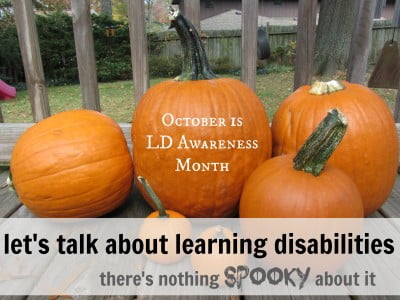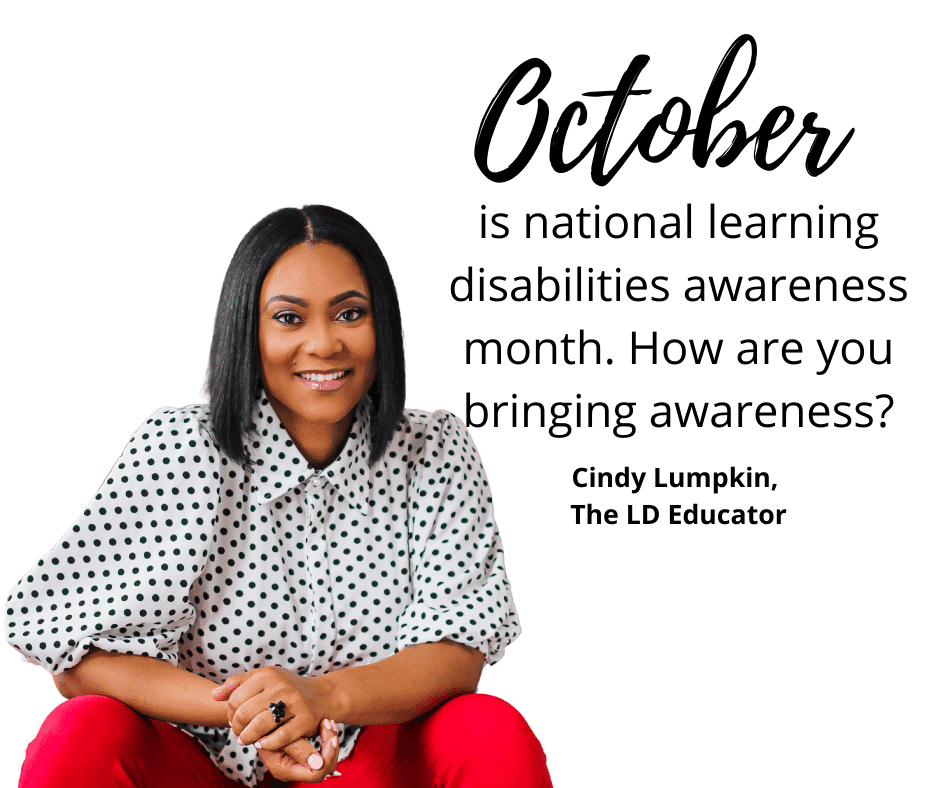October, Disabilities Awareness Month
On October 11, 1985, our then President Ronald Reagan signed Proclamation 5385 making the month National Learning Disabilities Awareness Month. We have come a long way, yet we still have so far to go in helping people understand what learning disabilities are and what they are not.
The President expressed clearly and articulately why learning disabilities awareness is so important:
…many Americans do not always find our language, numbers, and symbols natural and logical. They exhibit learning disabilities. In a sense, they are most aware of the deep complexity of our mental processes, for they must struggle to make the connections that, for most of us, are effortless habits.
Awareness of learning disabilities is one of the most important advances in education in recent years. As more and more Americans become aware, our citizens with learning disabilities will have even greater opportunity to lead full and productive lives and to make a contribution to our society.

Thirty-seven years later, awareness remains key to helping students with learning disabilities learn to cope and live with the effects of this neurological disorder.
Therefore, we have to work hard to make sure communities all around our nation are aware. We can do this by finding ways to observe LD Awareness Month.
Ways to Celebrate Learning Disability Awareness Month
The first and most important thing you should consider for LD Awareness Month is promoting the positive side of LD.
So many people see having a learning difference as shameful. Many students, both those with and without disabilities often count people with learning disabilities out.
They don’t realize how many people with these learning disabilities grow to do amazing things and how much impact many of them have had on our world.
The following are some things you can do to spread awareness among all your students and set the record straight as to how amazing people are who have LDs.
Highlight everyday people with learning disabilities.
Introduce your students (general and special) to everyday people who have overcome the effects of LD upon their life to lead productive lives.
Start by visiting LD Online to read the personal accounts of people who have learning disabilities.
You will soon learn that sometimes having a learning disability can be a superpower.
These personal accounts are all amazing stories of tenacity, love, acceptance, and success.
By giving successful, everyday people with learning disabilities exposure in the classroom setting, you help to reduce the stereotyping and stigma associated with LD
Doing so helps to demonstrate that you value every type of mind. Your students will learn to do the same.
Highlight quotes from famous people with learning disabilities.

I intentionally didn’t lead with this one. Why? You make ask.
I really want to make sure that we show students that you don’t have to be famous to live a successful life.
With that said, however, by giving famous people with learning disabilities exposure in your classroom setting, you help to reduce the stereotyping and stigma associated with LDs.
Quotes have the power to encourage, motivate and inspire people to action.
It is an easy way to remind yourself, your students, or your children that they have the ability to overcome life challenges.
You can access a list of quotes with graphics here.
Read a book about learning disabilities written by LD authors.
I’ve always said that if you really want to find out about learning disabilities, listen to the ones who have them.
Now please don’t take that as I am against research and the many great researchers who have contributed to what we know about learning disabilities.
It doesn’t have to be either or, it should be both. Research can only tell half the story.
Those who live this every day can tell the other half.
Whether you are an elementary, middle, or high school teacher, or college professor, the following books would be great additions to your libraries.
These are some of my favorite recommendations.
I Define Me
This book is an excellent selection for younger and older kids alike.
In fact, I used I Define Me to explain to my middle school class what Dyslexia was. They were very open and interested.
Here is a brief description of this book:
“I Define Me”, is a children’s book written by a nine-year-old young man. This heartwarming children’s book empowers students with learning differences and their parents by providing a candid peek into the life of Kyler Eric Smith. Kyler, born in Atlanta, Georgia, currently resides in Metro Atlanta with his mother, father, and thirteen-year-old brother. This autobiographical piece gives readers the unique opportunity to walk in the shoes of a bright, articulate, and multitalented child who has been diagnosed with dyslexia, dysgraphia, and dyspraxia. Rather than seeing these learning differences as obstacles, Kyler sees them as they are, challenges that through hard work, tenacity, and the right support system, can be overcome. Kyler frequently reminds others of this when he proudly shares his motto, “I Define Me”!
Undiagnosed: The Ugly Side of Dyslexia by Ameer Baraka
I’ve actually meet Ameer back in 2019 and have stayed connected via Facebook.
He is such an excellent role model and around good guy.
As of the printing of this blog, I haven’t read the book yet, it’s a new release, but I will soon.
This one is more suitable for the middle/high school level. Here is more about Undiagnosed:
“In UNDIAGNOSED, The Ugly Side of Dyslexia, Emmy nominated actor Ameer Baraka depicts how coming of age in the murderous streets of 1980s New Orleans collided with an unrecognized learning difference. Incarcerated for manslaughter at the age of fourteen, Ameer must reconcile his past with the will to persevere through the misconception that he’s unable to learn.
At age twenty-three, Ameer re-enters the prison system, where he reclaims an education denied to so many who struggle to read. His rage transforms into determination to help other inmates and young people recognize that through perseverance and education, there is an alternative to living a life of crime and a method to dismantle the school-to-prison pipeline. Stories speak louder than statistics, and in this tale of redemption, the good we do is measured by what we’ve overcome and the lives we inspire after discovering our truth.
Shame’s Prisoner: Overcoming the Academic and Emotional Effects of Learning Disabilities from a Teacher Who Experienced It
I could be a little biased, but Shame’s Prisoner is an excellent awareness guide for teachers, parents, and students.
There are not many books that explore the emotional impact of having a learning disability even for successful Dyslexics. This one does!
Many parents and teachers miss so many things, including insensitive remarks innocently spoken, but spoken just the same.
It’s such a great read; here is more about this book.
“An inspirational and practical guide – the first of its kind – to help parents, students and teachers understand the less talked about emotional side of learning disabilities (LD). In Shame’s Prisoner, Cindy Lumpkin, a special education teacher who experienced the struggles of growing up with a learning disability first hand, draws attention to and increases our understanding of how the shame of having a learning disability can impact a student’s self-worth even more than the academic challenges LD causes. An overcomer who has learned to strive in spite of her learning differences, Cindy offers tips and academic strategies for ultimate student success. Shame’s Prisoner is a brilliant, compassionate work that details Cindy’s experiences being educated in a public school special education program with essential insights crucial for parents, educators, and students on learning to embrace who they are, overcoming the academic effects of learning disabilities and becoming a self-advocate.”
I highly recommend any and all of these books to increase your and your students’ awareness of learning disabilities:
- Shame’s Prisoner…by Cindy Lumpkin
- Undiagnosed: The Ugly Side of Dyslexia by Ameer Baraka
- I Define Me by Kyler Eric Smith

Screen a documentary.
As educators, we know the power of having documentaries in our tool kit to help support our teaching.
Parminder Vir, a producer, and documentarian said it best:
“Documentary films tell important, often unknown stories and bring awareness to a wider audience, and are some of the best resources for information, inspiration, and entertainment. They have also become core elements and prompters of social issue campaigns.”
I have the perfect documentary for you, Normal Isn’t’ Real.
NORMAL ISN’T REAL is a series of 4 mini documentary-style videos featuring successful young adults sharing their stories of coming to terms with their LD and ADHD issues. These candid portraits take the viewer into the subjects’ daily lives; showcasing their talents, venting their frustrations, and employing the strategies they use to manage their challenges and utilize their strengths.
Viewers leave equipped with insights and tools they might adapt to their own lives, and a large dose of inspiration.
Our school hosted a community viewing of this event in 2019. It was AMAZING!
There are so many ways to use this film to bring awareness.
If you aren’t interested in doing a community viewing, you can use it just for your class.
You can do lesson’s around the 4 mini documentary-style videos in four days or 4 weeks (the entire month of October) for greater impact.
If you are interested in learning more about this film, click here.
Invite guest speakers.
Can you tell already that I really value first-person information? (I hope that is a good way to put that.)
But it’s true. For far too long, we treat people with learning disabilities as if they can’t speak for themselves- as if we can’t learn from them.
It’s like understanding the concept of People’s Frist Language. We have to value the “real” experts.
We value all the information we learned in our textbooks and the “experts”, but we very rarely consulted the person with the learning difference to bridge that information.
Moreover, we’ve done a great job providing instruction (at least our hearts are in the right place) but we’ve done a poor job of helping them heal from the trauma of the label.
Students need to see people who look like themselves, period.
Students with learning disabilities need to see successful people whose success is within their own reach.
We MUST be careful not to paint the picture that only rich, white people who have been able to provide top-of-the-line education services to their children are the only ones who have Dyslexia and other learning differences.
Of course, these students need to see themselves too, and they do! Dyslexia looks like a rich, white person disorder.
And some of the top private schools that serve these students, get it. They consistently have successful people guest speak at their school.
Kids of color and kids from lower-income backgrounds need to be able to see people that they can relate to or isn’t too outside of what they think they can become.
I know you are wondering how to find these people.
IG and other social media platforms.
You will be so surprised to know many everyday people are not only acknowledging that they too have learning differences, but they are also sharing their stories.
Use the #IamDyslexic to find some of these awesome people who would be more than happy to share with your class.
Wear a silver learning disability awareness ribbon.
This is a simple way to make a huge impact in your school.
Several years ago, we had the entire school where a ribbon to bring awareness.
Surprisingly, many of the students and staff wore their ribbons the entire week.
Hold a lunch and learn.
No teacher EVER said no to free lunch. LOL!!
The best way to grab anyone’s attention is to provide free food.
Now, I know what you are thinking, “How is this easy?”
Well, one, you will have a captive audience.
Two, no matter if this is for staff or students, you can find a local pizza place to donate a few pizzas to the cause.
Three, you are getting out there with your message. Even if it’s on a small scale, people will see the value you place on learning disabilities awareness month and start to ask questions.
Support a disability charity.
Rounding out our list of easy ways to bring awareness for learning disabilities awareness month, you can support a learning disability charity.
Even better, find one that isn’t a nationally known organization, but is doing impactful work.
If I may, let me suggest Triumph in Life, Inc. I founded this organization over 15 years ago. And we are for sure small and mighty.
Triumph in Life, Inc. is…
dedicated to giving students with learning differences the finest, most individualized, education and support they need to achieve their full potential in life. It is the schools’ aim to foster a greater understanding and support for all people with learning disabilities by training educators, supporting our families, and enlightening the community.
If you are interested, you can make your donation here.
I sure hope this list helps you as you plan to bring awareness this year for learning disabilities awareness month.
Often, there are so many questions surrounding this month so I’ve taken the liberty to ensure you are totally aware as you make your plans.
So, let’s keep reading.
What are the 7 main types of learning disabilities?
- Dyslexia
- Dysgraphia
- Dyscalculia
- Auditory Processing Disorder
- Language Processing Disorder
- Nonverbal Learning Disabilities
- Visual Perceptual/Visual Motor Deficit
Is October Dyslexia Awareness Month 2022 or Learning Disabilities Awareness Month
If October is officially Learning Disabilities Awareness Month, why am I seeing it called Dyslexia Awareness Month?
To make a long story short, the term learning disabilities represent several disabilities without calling them by their name.
Look at the question before this one: What are the 7 main types of learning disabilities?
As you can see Dyslexia is one learning disability among many common learning disabilities.
There are many organizations that advocate for calling the learning disability, Dyslexia by its name.
In fact, one year the hashtag, #SayDyslexia went pretty much viral.
So, I guess it really depends on who you ask.
However, to only say Dyslexia leaves out so many other learning disabilities.
But, the vast amount of people with learning disabilities is Dyslexic or Dyslexic with multiple learning disabilities.
Kyler Eric Smith, I Define Me author, mentioned above is an example of this.
Does Dyslexia Have an Awareness Month?
Yes, but it’s complicated. LOL!
October is technically Dyslexia Awareness Month, but only because it’s Learning Disabilities Awareness Month.
For a better understanding, read the question/answer above.
How Do You Celebrate Dyslexia Awareness Month?
You can still do the exact same things mentioned in this article:
- Highlight everyday people who have Dyslexia.
- Highlight quotes from famous Dyslexic people.
- Read a book about Dyslexia written by a Dyslexic author.
- Screen a documentary about Dyslexia.
- Invite guest speakers.
- Hold a lunch and learn.
- Support a disability charity.
- Wear a silver learning disability awareness ribbon.
Although I think the above is more creative and will do a really go job in bringing awareness, Learning Ally lists several that could help do the trick.
When is Dyslexia Awareness Week?
October 3rd- 9th, 2022
Is There a National Dyslexia Day?
October 6th, 2022 is World Dyslexia Day
Other Facts: Learning Disabilities Awareness Month
According to the National Center for Learning Disabilities, 15-20% of the U.S. population has a learning disability and 2.4 million students are currently diagnosed with LD.
In addition, shocking statistical data and survey results conducted by the organization discovered:
- Over 66% of parents want more information about learning disabilities than schools currently provide.
- 43% of Americans, including teachers, wrongly believe that LD is correlated with IQ.
- 20% of students with LD drop out of high school vs. 8% of students in the general population.
- Among working-age adults with LD versus those without LD: 55% vs. 76% are employed; 6% vs. 3% of adults are unemployed, and 39% vs. 21% are not in the labor force partly because of lack of education.
While some educational outcomes for students with learning disabilities have shown improvements in recent years, overall they remain unacceptably low.
This is why learning disabilities awareness is so important.
With numbers like these, one can see why there is a need to not only talk about learning disabilities but to keep talking until things get better for our most vulnerable learners.
Make plans now to bring awareness to your classroom and community. That is what October is all about- Learning Disabilities Awareness Month.
Here’s to October, Learning Disabilities Awareness Month.
Thank you for sharing this critical information!
You are so welcome!!! Are you or did you do anything to celebrate this year?